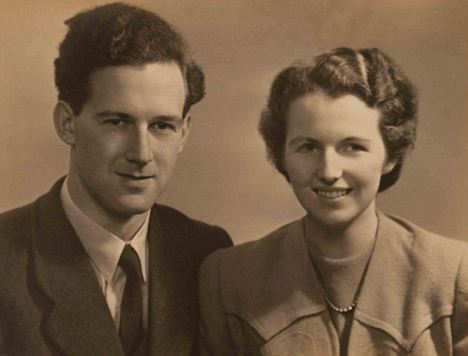<Back to Index>
- Codebreaker Keith Batey, 1919
- Mathematician John R.F. Jeffreys, 1918
PAGE SPONSOR

Keith Batey (4 July 1919 - 28 August 2010) was a code breaker who, with his wife, Mavis Lilian Batey (née Lever, 5 May 1921 - 12 November 2013), worked on the German Enigma machine at Bletchley Park during the World War II.
Keith Batey was at Carlisle Grammar School and went on to study mathematics at Trinity College, Cambridge, under a state scholarship, where he met Gordon Welchman, who would later assemble a group of code breakers for Bletchley Park at the outbreak of the war.
Batey was recruited by Welchman in 1940 and worked in Hut Six, which was responsible for breaking the German Army and Air Force Enigma ciphers. While there he met fellow code breaker, Mavis Lever, who worked with Dilly Knox's research section, reconstructing new Enigma machines as they were introduced. Batey assisted Lever in reconstructing one of the rotors of a new Italian Enigma machine and they soon fell in love and were married. In 1942, Batey wished for a more physically active role in the war as a pilot in the RAF, but was rejected due to his knowledge of Ultra and the risk of getting captured. Instead, he persuaded the authorities to allow him to train as a pilot with the Fleet Air Arm for the defense of Canadian waters. However, he was called back to work in a newly created section known as ISK, standing for Illicit Services (Knox) alongside his new wife. Dilly Knox had just reconstructed the main Enigma cipher machine used by the Abwehr, German military intelligence, and the ISK section was to play a key role in the Double Cross System which "turned" German agents sent to Britain and elsewhere in the world and used them to feed false intelligence back to the Germans. During 1943, Batey broke the Enigma ciphers of the Sicherheitsdienst, the Nazi party's intelligence service, along with the cipher used by Italian military attachés in Berlin.
After the war, Batey worked with the Commonwealth Relations Office and joined the High Commission in Ottawa, Canada. He worked there until 1951 when he transferred to become the private secretary to Philip Noel - Baker, Secretary of State for Commonwealth Relations.
Batey subsequently worked as the Secretary of the Chest, the official title for the chief financial officer of the University of Oxford, before becoming Treasurer of Christ Church in which role he played a key part in refurbishment of the Oxford college's historic buildings.
Batey remained largely silent on his war work while his wife Mavis became much better known, cooperating with a number of books and television series, including Station X, the book of which went on to become a U.K. number one bestseller. They advised actors Kate Winslet and Dougray Scott on what it was like to be a code breaker at Bletchley for the Hollywood film Enigma.
The Bateys demonstrated how the Abwehr Enigma machine worked during a visit by Prince Charles and the Duchess of Cornwall to Bletchley Park in 2008.
John R.F. Jeffreys (25 Januay 1916 - 13 Januay 1944) was a British mathematician and World War II code breaker.
A research fellow at Downing College, Cambridge, Jeffreys joined the code breaking efforts at Bletchley Park in September 1939 alongside fellow Cambridge mathematicians Gordon Welchman, with whom he had previously worked closely, and Alan Turing. These three, together with Peter Twinn and working under Dilly Knox, formed the research section working on the German Enigma machine, and were housed in "The Cottage" at Bletchley Park.
Jeffreys was put in charge of a small section manufacturing perforated sheets for use in the cryptanalysis of the Enigma, a task which took over three months, completed on 7 January 1940. One type were the Zygalski sheets, known as Netz at Bletchley Park, a technique revealed to the British by Polish cryptologists. Another type, named "Jeffreys sheets", were different, and were a "catalogue of the effect of any two Enigma rotors and the reflector". Jeffreys's perforated sheets were used by Polish cryptologists in exile in France to make the first wartime decryption of an Enigma message on 17 January 1940.
In early 1940, a section called "Hut 6" — named after the building in which it was initially housed — was created to work on solving German Army and Air Force Enigma messages. Jeffreys was chosen to run the hut alongside Welchman. Jeffreys was in charge of "Sheet - Stacking and Machine Room activities", while Welchman handled "Registration, Intercept Control, Decoding, and relations with the intelligence people in Hut 3".
In May 1940, Jeffreys took a vacation, but became ill and was diagnosed with tuberculosis and diabetes. He died in March 1944.
Gordon Welchman later recalled:
- "Jeffreys was very much liked at Bletchley Park. His death was a
tragic loss to all of us. We felt deep sympathy for his fianceé, Pat
Hempsted, who had been a member of his team from its beginnings in the
Cottage. She was involved both in the initial punching of the sheets and
in the testing of drops on which our early breaks depended."